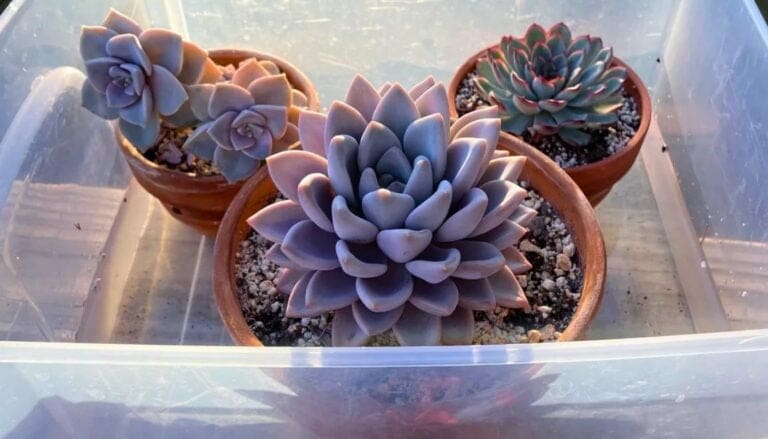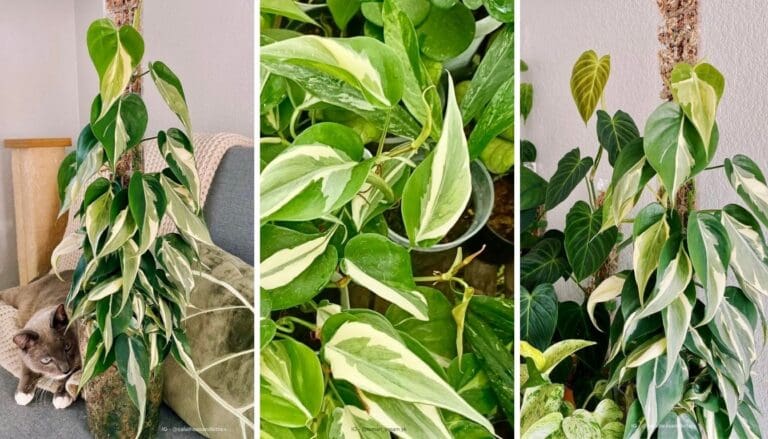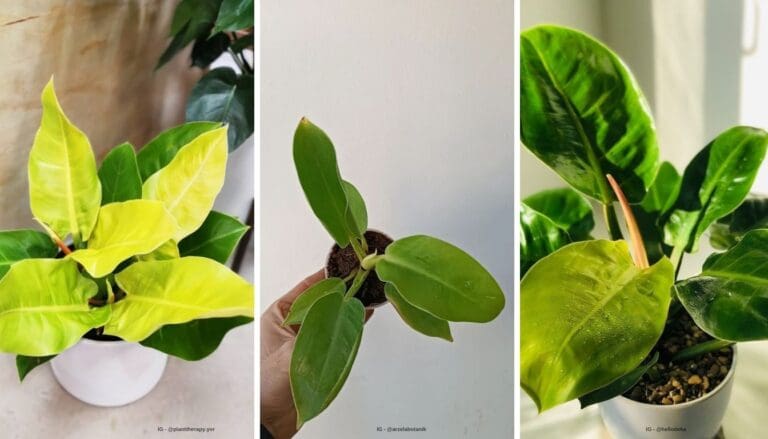11 Easy To Make DIY Indoor Plant Trellis Ideas
I’m always on the lookout for simple ways to help my indoor plants stand out. A trellis adds height, shape, and a little charm—without eating up precious space.
With just a few materials, you can build a unique trellis that helps your plants grow strong and look beautiful.
You’ll see how easy it is to turn everyday stuff like wood, wire, or string into creative plant supports. Each idea fits different styles and spaces, so you can pick what works for your home and your plants.
Please note: Simplify Plants is reader-supported. As an Amazon Associate, I earn from qualifying purchases made by our readers with no extra cost added to you all! Some links in the post are affiliate links and I get a commission from purchases made through links in the post.
1) Bamboo Skewer Trellis

I really enjoy using bamboo skewers because they’re cheap, easy to find, and just simple to work with. They fit nicely in smaller pots and look neat with most houseplants.
Honestly, I can make one in a few minutes with things I already have at home. To start, I grab a handful of bamboo skewers, some string or twine, and scissors.
I poke the skewers into the soil around the plant, making sure they’re upright and spaced out. The number depends on how much support my plant needs and the size of the pot.
Next, I tie the tops together with twine, making a little pyramid shape. This helps vines or climbers grow upward.
If the plant spreads out more, I’ll tie some horizontal lines of string between the skewers for extra support. I like that this trellis looks natural and clean—the light bamboo blends in with green leaves.
Sometimes I’ll paint the skewers or wrap them with colored string if I want a pop of color. This trellis works great for pothos, philodendron, or small ivy plants.
It keeps stems off the soil and helps them grow stronger. When the plant outgrows the trellis, it’s super easy to make a bigger one or just add more skewers.
I appreciate that bamboo is eco-friendly and reusable. If a skewer snaps, no big deal—I just swap it out.
Making a bamboo skewer trellis takes just a few minutes, and the result is both practical and attractive. It’s honestly one of my favorite quick plant projects.
2) Wooden Dowels Trellis
I like using wooden dowels since they’re easy to find and work well with most indoor plants. They look clean and natural, which helps the plants stand out.
Dowels are light, so moving the trellis around isn’t a hassle. To make one, I grab a few thin wooden dowels, some twine or wire, and scissors.
I cut the dowels to fit the height of my plant pot and push them into the soil in a simple shape—usually a teepee or square frame. Then I tie the tops together with twine to keep everything steady.
For climbing plants, I’ll add a couple horizontal pieces for extra spots to grab. It only takes a few minutes to set up.
Sometimes I’ll paint or stain the dowels to match my room, or just give them a light coat of clear sealant to protect the wood. That little step helps keep things looking neat for a while.
When it’s in the pot, I gently guide the plant’s stems toward the trellis. The plant usually starts wrapping around the dowels on its own.
I like how simple and affordable this project is. It uses basic stuff and doesn’t need any special tools.
3) Copper Pipe Trellis
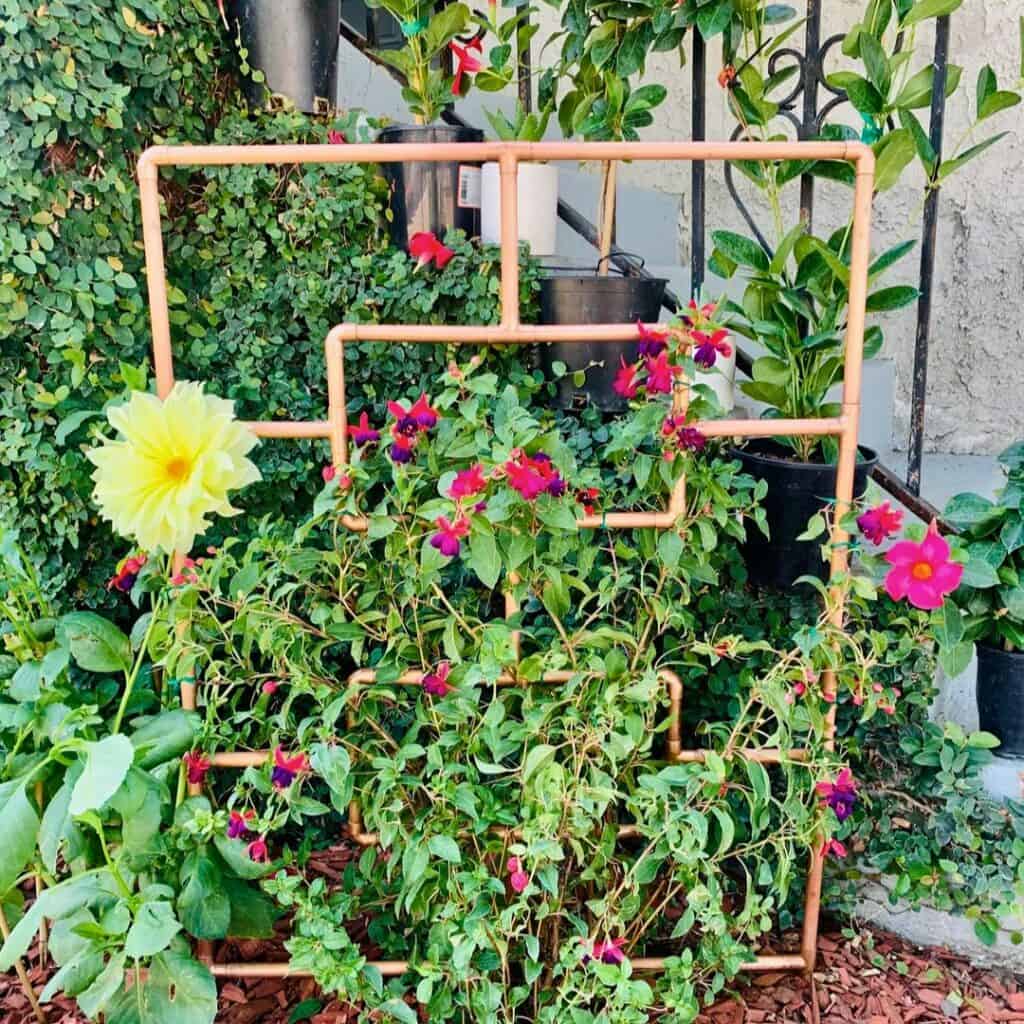
I’m a fan of copper pipes because they look clean and modern. The shiny metal is a nice touch for my indoor plants.
Copper is strong enough to hold heavier vines, but it’s still easy to work with. I start by measuring the space where I want the trellis.
Then I cut the copper pipes into equal lengths with a pipe cutter. I connect the pieces using elbow and T-joints to make a grid or ladder shape.
Once the frame is ready, I press it into the potting soil or attach it to the back of the planter. Copper develops a soft patina over time, which honestly gives it a warm, rustic vibe.
This trellis works well for pothos, philodendron, or ivy. The vines wrap around the pipes easily, and the structure supports steady growth.
Sometimes I’ll polish the copper if I want it shiny, but the aged look is pretty nice too. It’s a straightforward project and doesn’t take long.
I only need a few tools, and the result looks neat and sturdy. Building a copper pipe trellis gives my plants a stylish frame and adds a bit of personality to my space.
4) String and Stick Trellis
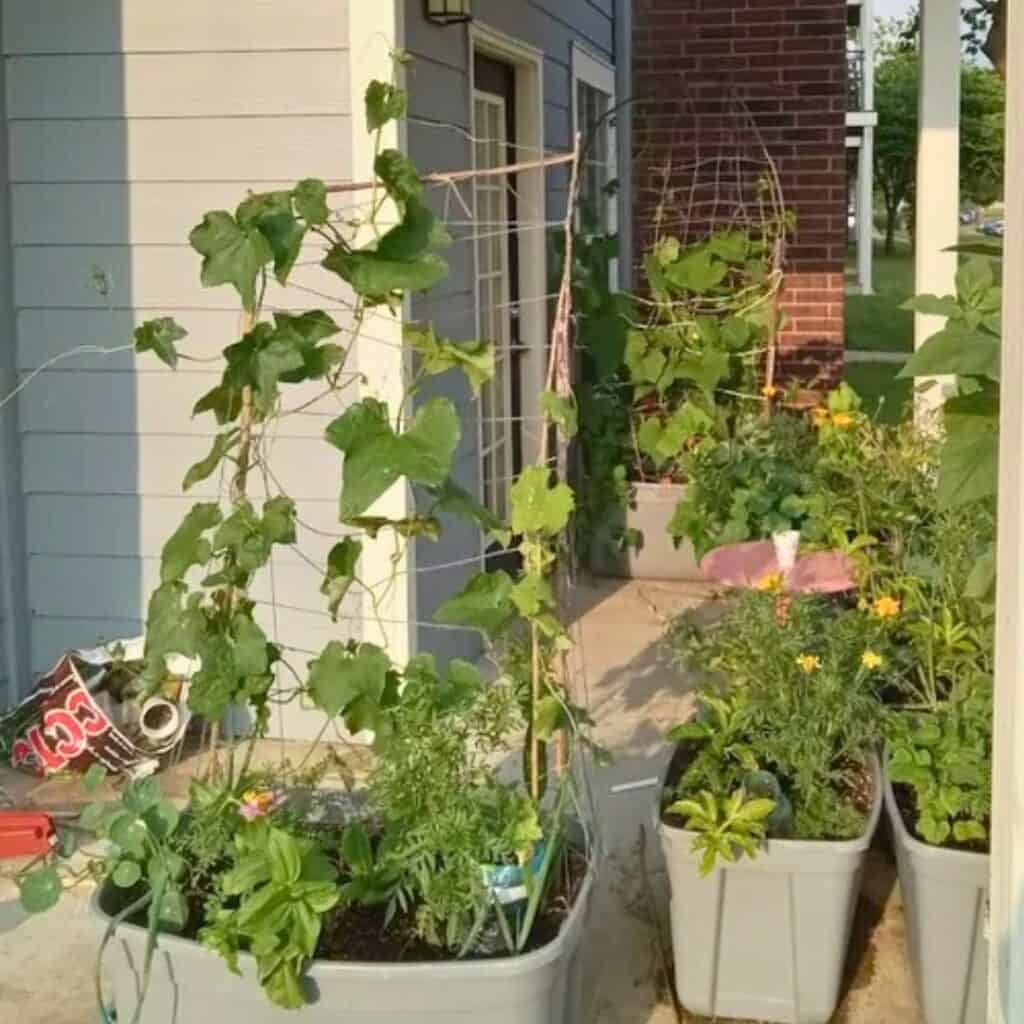
I like this simple and low-cost trellis because it uses things I usually already have lying around. A few straight sticks and some string can become a clean, natural-looking support for climbing plants.
I start by finding four to six sturdy sticks about the same length. I push them into the soil around the edge of the pot, making sure they’re standing firm.
Next, I tie string or twine between the sticks in a crisscross pattern. I keep the lines tight so the plants can grab onto them as they grow.
The pattern can be square, diamond, or whatever I’m in the mood for. I like using natural jute or cotton string because it blends in and is gentle on the stems.
If I want a cleaner look, I’ll use thin nylon cord in a neutral color. This trellis works well for small indoor vines like pothos, ivy, or philodendron.
It gives them a place to climb without hogging space. I also like how easy it is to adjust or replace the string if it gets loose.
I can move the sticks closer or farther apart depending on how my plant grows. When I want a bit of style, I’ll paint the sticks or wrap them with colored yarn.
This setup keeps my plants upright, saves space, and looks neat. It’s a quick project that really makes a difference in how my plants grow indoors.
5) Wire Grid Trellis
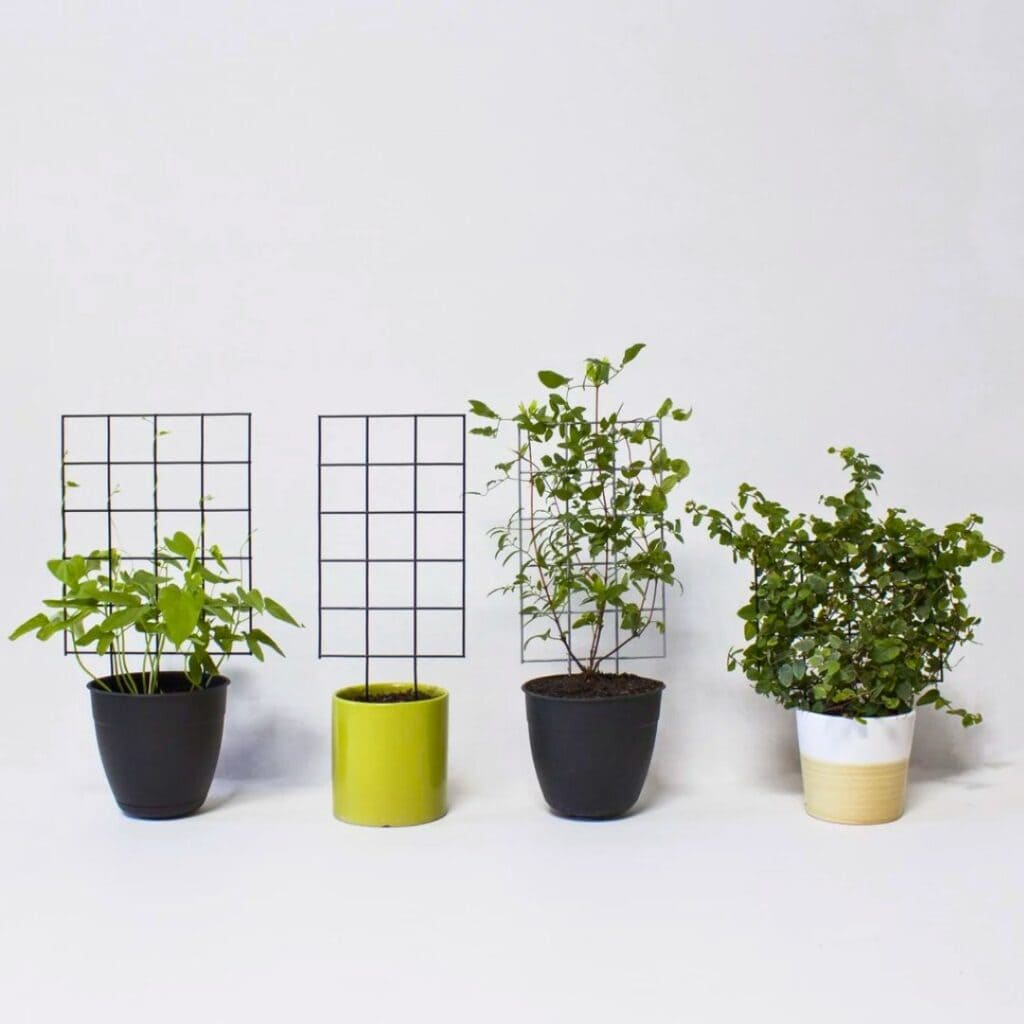
I like using a wire grid trellis because it looks clean and works for so many indoor plants. It’s simple to make and takes up barely any space.
To start, I grab a metal grid panel or make one from sturdy wire. I’ll shape it into a square or rectangle, depending on the size of my plant and the wall.
I attach the grid to the wall using hooks or adhesive strips that can handle the plant’s weight. If I want a freestanding version, I connect the grid to a small pot or planter frame.
Once the grid is secure, I gently guide the plant stems through the openings. As it grows, I keep weaving the vines to help them spread out.
I like spray-painting the wire grid in a color that matches my decor. Black, white, or gold are my go-tos—they just look good in most rooms.
This trellis works great for pothos, philodendron, and ivy. These plants climb easily and fill the grid with greenery over time.
The grid creates a modern, organized look. It can turn a plain wall into a living display—without making things feel cluttered.
To keep it tidy, I trim overgrown vines and wipe the wires with a damp cloth. If I want to switch things up, I can move the grid or hang small planters from it.
A wire grid trellis is one of my favorite DIY projects because it’s affordable, quick, and adds a stylish touch to any space.
6) Macrame Plant Hanger Trellis

I love how macrame brings both style and function to my indoor plants. A macrame plant hanger trellis gives vines and trailing plants a place to climb, and it’s a cute handmade touch.
It’s simple to make and doesn’t need much. I start with cotton cord, metal or wooden rings, and scissors.
I measure and cut several equal strands, tying them to the ring with strong knots. These cords form the base and support the plant’s weight.
Next, I make basic macrame knots like square or spiral knots. I keep the pattern loose so the plant can weave through as it grows.
The open design lets air and light reach the leaves, which helps the plant stay healthy. I hang the finished trellis near a window or in a bright corner.
It works well for pothos, philodendron, or ivy—any plant that likes to climb or trail. The cords guide the vines upward, keeping them neat and off the floor.
When I water the plant, I check the cords to make sure they’re dry and secure. If they stretch, I just adjust the knots or tighten them.
I like how each macrame piece feels unique and personal. I can pick different cord colors or add little wooden beads if I’m feeling creative.
A macrame plant hanger trellis fits well in small spaces. It saves shelf space and adds greenery to walls or windows.
7) Ladder Style Trellis

I love using a ladder-style trellis because it looks clean and works well in small spaces. The simple design makes it easy to build and fit into any indoor corner.
It also adds a nice vertical touch that draws the eye upward. To make one, I start with two wooden dowels or old ladder sides and connect them with short crosspieces.
I use nails or strong glue to hold everything together. The result is a sturdy frame that supports climbing plants like pothos or ivy.
I like to paint or stain the wood to match my room’s decor, or sometimes I just leave the wood unfinished for a rustic feel. A light coat of clear sealant helps protect it from moisture.
Once the frame is ready, I place it behind a potted plant and gently guide the vines upward. The open rungs make it easy to weave stems through as they grow.
This style works well for indoor gardens or window displays. It doesn’t take up much floor space and can even lean against a wall.
I often move mine around when I rearrange my plants, and it always fits right in. The best part is how customizable it is.
I can make it tall for big plants or short for tabletop pots. It’s a quick weekend project that adds both function and charm to my indoor garden.
8) Popsicle Stick Trellis
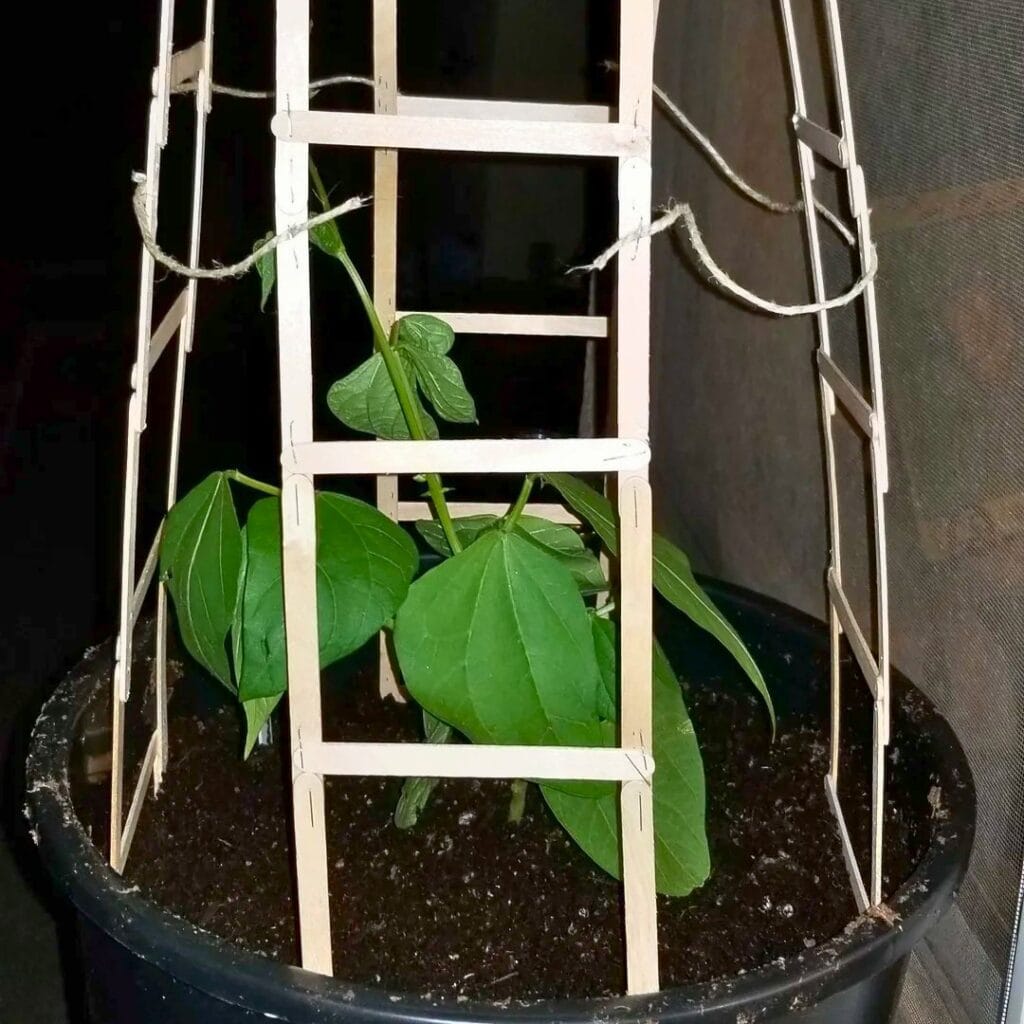
Honestly, I love using popsicle sticks for small indoor plants. They’re cheap, easy to find, and actually pretty fun to work with.
This project just takes a few minutes and gives your plants a cute little place to climb.
I usually grab popsicle sticks, glue, and scissors to get started. Then I lay the sticks flat and mess around with a grid or triangle shape, depending on how big I want it.
Once I’ve got the shape, I glue the ends where the sticks cross. I let the glue dry all the way so the frame doesn’t fall apart.
If I want it sturdier, I’ll add another layer of sticks on the back. Sometimes I get a little carried away with the glue, but it works out.
After it’s dry, I like to paint or stain the sticks. Sometimes I go for bright colors if I’m in the mood, or just keep it natural for a cleaner look.
I gently press the trellis into the soil near my plant. Then I guide the vines or stems toward the sticks and hope they cooperate.
It’s honestly satisfying to watch the plant start wrapping around the little ladder I made.
This mini trellis is best for light vines or young plants like pothos, ivy, or string of hearts. It’s not going to hold up heavy stems, but it gives smaller plants a bit of structure.
I like that I can change the size and shape whenever I want. If my plant grows taller, I just glue on a couple more sticks.
It’s a quick fix and I don’t have to buy new supports every time.
Making a popsicle stick trellis adds a handmade touch to my indoor garden. It’s simple, cheap, and honestly gives me a nice creative break while helping my plants grow in a tidy way.
9) Twine and Branch Trellis
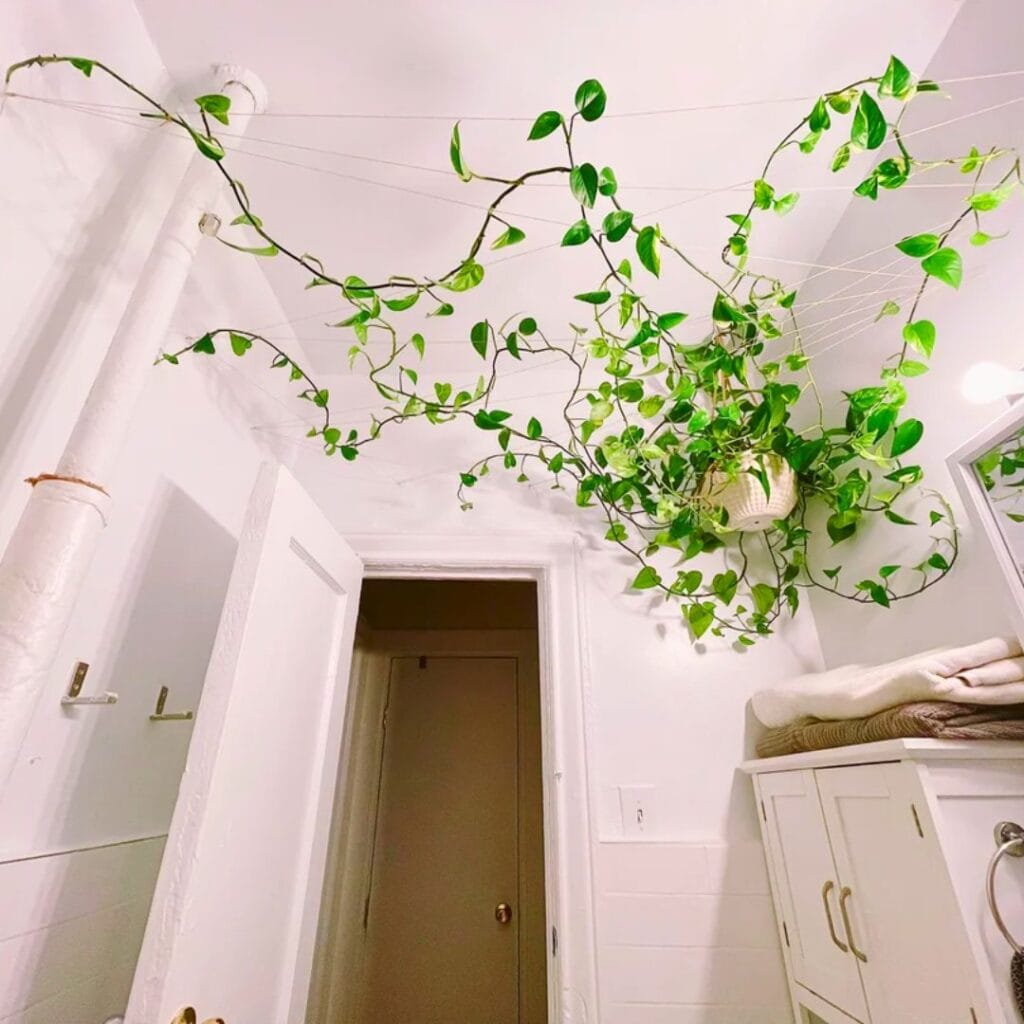
I’m a fan of using natural branches and twine to make a simple indoor trellis. It gives my plants support and brings a bit of rustic charm inside.
Usually, I just find branches in my yard or at a park—nothing fancy.
First, I pick out straight, sturdy branches that fit my pot. I clean off the dirt and trim the ends so they stand up straight.
How many branches I use really depends on how wide I want the trellis.
Then I tie twine between the branches to make a grid or ladder shape. I try to keep the twine tight so the vines have something to grab.
Sometimes I use colored twine or natural jute if I want it to look a little more decorative.
I push the branches deep into the soil so they stay put. For extra stability, I’ll press the soil around the base or toss a few small rocks on top.
The trellis should feel solid before I let the plant start climbing.
You can also use twine along with wall hooks to make a trellis out of it.
This setup works well for small indoor vines like pothos, ivy, or philodendron. It gives them a place to grow up instead of sprawling everywhere.
I like how it keeps the plant neat and saves space on my table.
Over time, the twine might loosen or the branches shift a bit. When that happens, I just retie the twine or swap out a branch.
It only takes a couple minutes to tidy things up.
Using twine and branches makes the trellis look natural and handmade. It’s easy, costs next to nothing, and helps my plants grow strong.
10) Metal Hoop Trellis
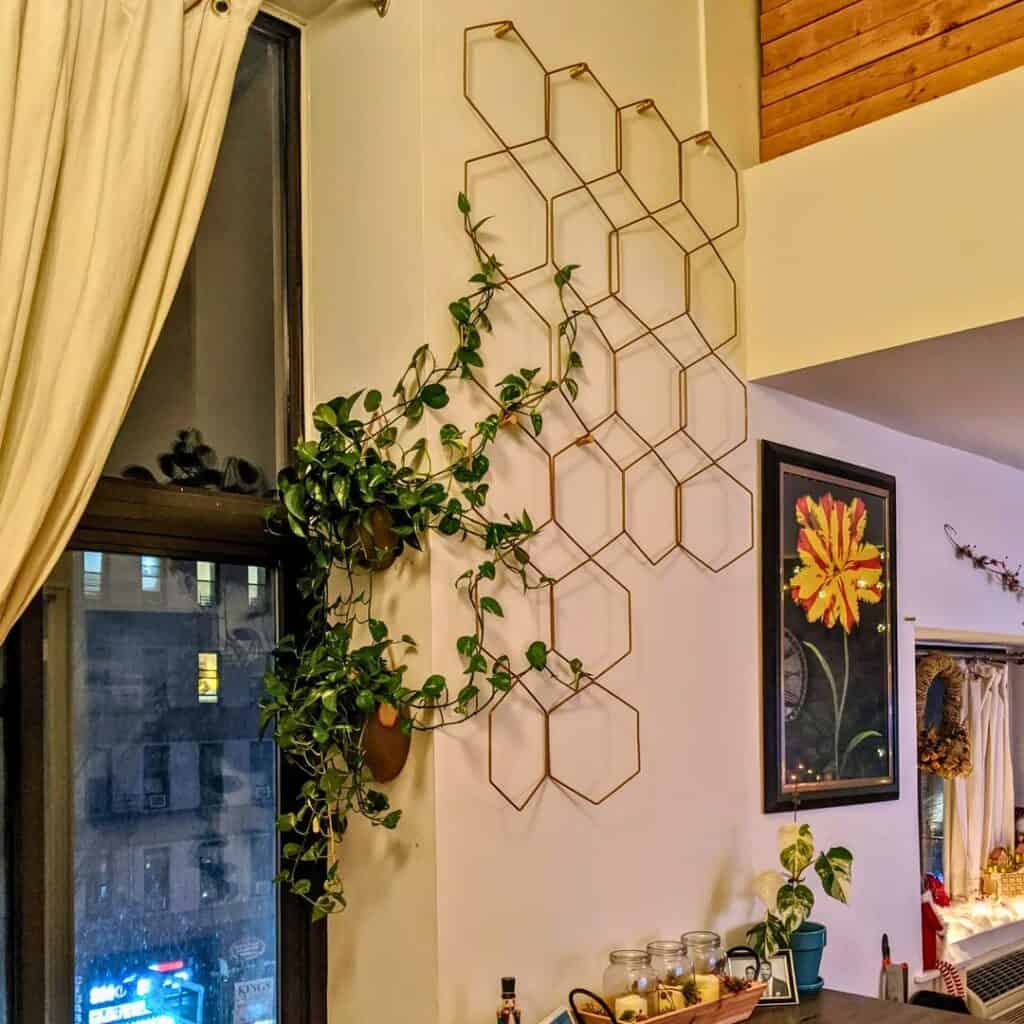
I really enjoy making a metal hoop trellis because it looks neat and works for a bunch of indoor plants. It’s simple to put together and gives climbing vines a strong frame to grow on.
To start, I grab two or three metal hoops from the craft or garden store. I pick a size that fits the pot and the spot where it’ll go.
I connect the hoops with zip ties or thin wire to make a dome or arch. This step keeps everything steady but still looking light.
Then I push the ends of the hoops into the soil around the plant. If the pot’s shallow, I add small wooden stakes or clips so the trellis doesn’t tilt.
Before using them, I like to spray the hoops with rust-resistant paint. It helps them last and adds a nice color accent.
Black, white, or gold usually look best to me.
Once the trellis is set, I gently guide the plant’s stems through the hoops. I use soft plant ties or twine so I don’t hurt the vines.
This design works great for pothos, philodendron, or ivy. The round shape helps the leaves spread out and catch more light.
I also love that the metal hoop trellis makes watering easier. The open design lets air move around, which helps prevent mold.
If I want to mix things up, I’ll add small hanging ornaments or fairy lights to the hoops. It gives the plant display a cozy, decorative vibe.
Building this trellis takes hardly any time or money, but it adds a modern look to my indoor garden. It’s honestly one of my favorite quick DIY projects for keeping plants upright and stylish.
11) Reclaimed Wood Pallet Trellis
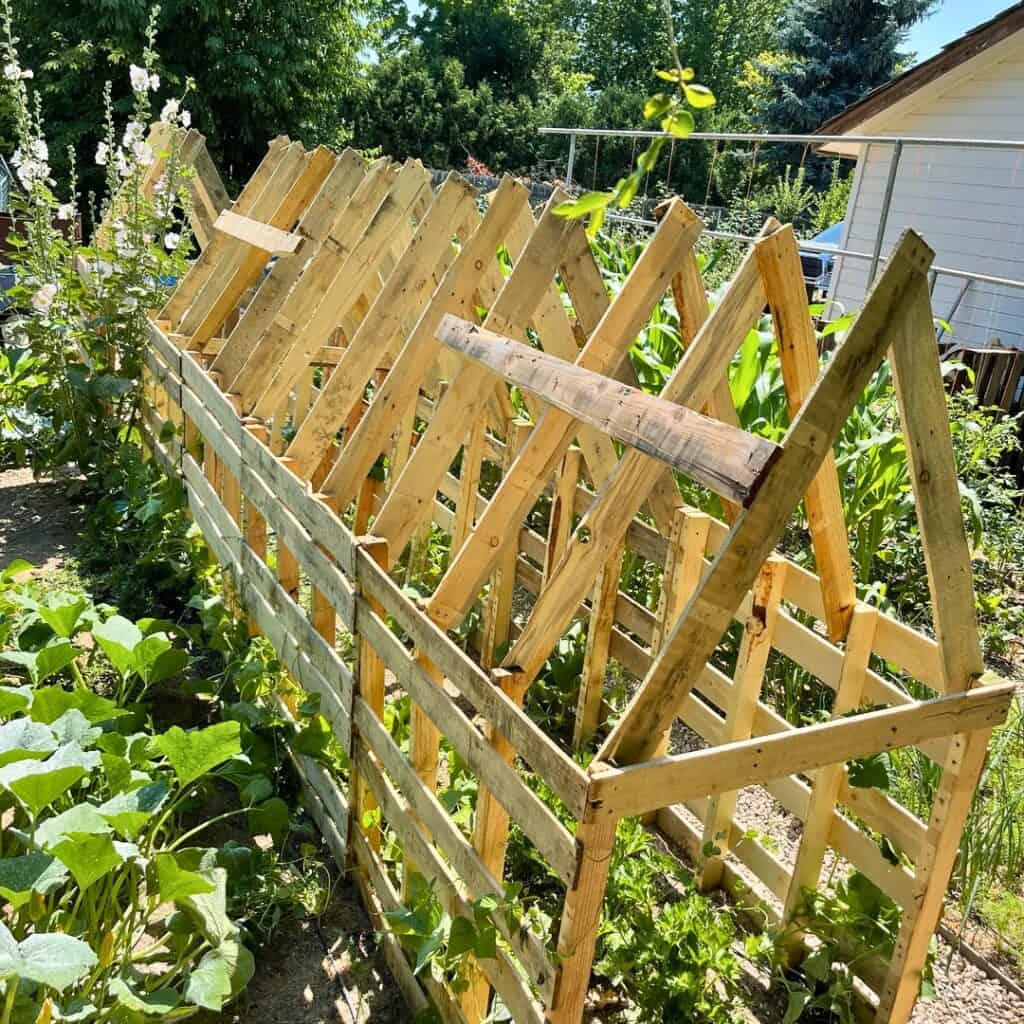
I love using reclaimed wood pallets because they add a rustic touch and help cut down on waste.
They’re surprisingly easy to find—hardware stores, behind shops, you name it. With a bit of cleaning and sanding, I can turn them into a sturdy trellis for my plants.
First, I remove any nails or rough edges so the wood’s safe to handle. Then I decide if I want the pallet whole or cut into smaller chunks.
The size just depends on my space and which plants I’m working with.
I usually stand the pallet upright and secure it to a wall or planter box. This gives climbing plants like pothos or ivy lots of room to spread.
The gaps between the slats are perfect for vines to weave through.
Sometimes I paint or stain the wood to match my room. A light coat of sealant helps keep moisture out.
Even a simple finish makes it look polished and helps it fit in with the rest of my décor.
Once it’s set up, I gently train the plant stems to climb the slats. I use soft ties or twine so I don’t damage any leaves.
Over time, the vines fill in the spaces and create a green, textured wall.
What I like most is that each pallet trellis looks different. The wood grain, color, and size always vary, so every piece has its own character.
It’s a budget-friendly way to add height and interest to my plants while reusing what I’ve already got.
Choosing the Right Materials for Your DIY Plant Trellis
I try to pick materials that are lightweight, sturdy, and safe for indoor use.
I also think about how they match my space and whether they’re easy to clean or move.
The right materials help my plants grow strong and keep things looking tidy.
Best Materials for Indoor Trellises
I often use bamboo, wood dowels, or metal rods. They’re strong and easy to work with.
Bamboo is light and gives a natural look that fits most spaces.
Wood dowels are easy to cut and paint, so they’re great for custom designs.
Metal rods or wire grids work really well for climbing plants like pothos or ivy. They’re durable and don’t bend easily.
I make sure to pick coated or rust-resistant metal so I don’t end up with stains or damage from moisture.
| Material | Strength | Look | Maintenance |
|---|---|---|---|
| Bamboo | Medium | Natural | Low |
| Wood | Medium | Warm | Moderate |
| Metal | High | Modern | Low |
I always check that the materials are non-toxic and safe for plants. Smooth edges and stable bases help keep stems from breaking or slipping.
Eco-Friendly and Budget Options
When I want to save money or just avoid waste, I like to reuse old household items.
I’ve made trellises from reclaimed wood, coat hangers, and string or twine. These cost almost nothing and keep stuff out of the trash.
Sometimes I’ll use sticks from the yard or fallen branches, cleaned and trimmed to size. They look rustic and blend in with my plants.
For small plants, I tie cotton string or jute twine between wooden frames. These natural fibers let plants climb and break down safely over time.
Using what I already have makes each trellis feel personal and eco-friendly. Plus, it keeps my budget low.
Caring for Plants on Indoor Trellises
I keep my trellis plants healthy by paying attention to how much light and water they get, and by guiding their growth so they stay neat.
These habits make a big difference in how well my plants do indoors.
Watering and Light Considerations
I check the soil often because overwatering is a classic mistake.
When the top inch feels dry, I water slowly until a little drains out the bottom. That keeps the roots moist but not soggy.
Light is just as important. I put my trellised plants near a bright window with indirect sunlight.
Direct sun can burn leaves, especially for softer vines like pothos or philodendrons.
If natural light is low, I use a grow light for 10–12 hours a day. I keep it about a foot above the plants so the leaves don’t scorch.
| Light Type | Ideal Duration | Notes |
|---|---|---|
| Bright indirect | 6–8 hours | Best for most indoor vines |
| Low light | 10–12 hours with grow light | Use LED or fluorescent bulbs |
I also rotate the pots every week so each side gets some light and grows evenly.
Training Vines and Stems
I gently guide new stems toward the trellis using soft plant ties or twist ties.
I try not to pull or bend stems too much—these things snap faster than you’d think.
When vines get too long, I trim them just above a leaf node. It helps the plant branch out and look fuller.
I check the ties every few weeks. As stems get thicker, I loosen or move the ties so they don’t cut in.
For climbing plants like ivy or jasmine, I weave the stems through the trellis holes instead of tying everything down.
This keeps the plant secure but still lets it grow naturally.
Regular training keeps the shape tidy and helps the plant grow up instead of spreading all over the place.
Frequently Asked Questions
I like using simple, low-cost materials to build trellises that fit my space and help my plants grow tall.
I also look for eco-friendly, space-saving, and beginner-friendly ideas to make indoor gardening easier.
What are some simple materials I can use for a DIY indoor plant trellis?
I often use bamboo skewers, wooden dowels, copper pipes, string, and wire grids.
They’re easy to find, cut, and shape. Plus, they blend well with most décor.
How can I create a trellis for small indoor plants?
For small plants, I like to make mini trellises with bamboo skewers or thin sticks.
I tie them together with twine or string to form a little grid. It keeps the plant upright and doesn’t take up much space.
Are there any quick trellis projects for beginners?
Definitely. The String and Stick Trellis or the Wire Grid Trellis are both great.
They take less than an hour and only need a few tools. Perfect for quick results.
What are some creative ways to support climbing plants indoors?
I like shaping copper pipes into geometric frames or hanging string trellises on the wall.
These look modern and help vines climb neatly. Painting the frame to match your room is a nice touch, too.
Can you suggest eco-friendly trellis ideas for my indoor garden?
I recommend reusing old wooden dowels, bamboo, or sticks from the yard.
Tying them with natural jute or cotton twine instead of plastic keeps the project sustainable and biodegradable.
How do I make a trellis that can fit in a small space?
If you’re short on space, I like to go with vertical trellises that just lean up against a wall or even tuck right into a pot.
Honestly, a wire grid or a simple string design does the trick—they barely take up any room but still manage to keep your climbing plants happy.
Recommended Garden Supplies
| Product Image | Our Recommended Gardening Supplies | Check Offers! |
|---|---|---|
Top Top
Top
Top
Top
Top
Top
Top
Top | rePotme Houseplant and Tropical Classic Potting Soil Mix | Check Offer On Amazon |
 Top
Top
Top
Top
Top
Top
Top
Top | Espoma Organic Indoor Plant Food | Check Offer On Amazon |
 Top
Top
Top
Top
Top
Top
Top
Top | GooingTop LED Grow Light 6000K Full Spectrum Clip Plant Growing Lamp | Check Offer On Amazon |
 Top
Top
Top
Top
Top
Top
Top
Top | Soil Moisture Meter | Check Offer On Amazon |
 Top
Top
Top
Top
Top
Top
Top
Top | Govee Hygrometer Thermometer, Bluetooth Enabled! | Check Offer On Amazon |
 Top
Top | LEVOIT Humidifiers for Large Room(Best For Plants) | Check Offer On Amazon |
 Top
Top
Top
Top
Top
Top
Top
Top | Upgraded DIY Automatic Drip Irrigation Kit, 15 Potted Houseplants Support | Check Offer On Amazon |
 Top
Top
Top
Top
Top
Top
Top
Top | Stainless Steel Heavy Duty Gardening Tool Set | Check Offer On Amazon |
 Top
Top
Top
Top
Top
Top
Top
Top | Bonide Insecticidal Soap | Check Offer On Amazon |
 Top
Top
Top
Top
Top
Top
Top
Top | Bonide 32 oz Spray Neem Oil for Organic Gardening | Check Offer On Amazon |
 Top
Top
Top
Top
Top
Top
Top
Top | Garden Safe Fungicide | Check Offer On Amazon |
Note: Some images in the articles are sourced from Reddit and Other Platforms For Reference Purpose.

